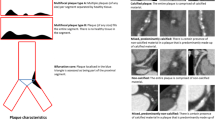Abstract
Arterial lumen volume, determined by sequential coronary angiography, could have advantages over more commonly used variables (such as percent stenosis or minimal lumen diameter) as a primary endpoint in clinical trials evaluating post-angioplasty restenosis or atherosclerotic plaque progression. We validated a quantitative coronary angiography analysis (QCA) system aimed at measuring lumen volume from coronary angiography films by a densitometric method. Using images of polyacrylate models filled with different concentrations of contrast medium, accuracy (mean of the differences between known and measured values of a measurement) and precision (standard deviation of the difference) were lower than or equal to 0.09 and 0.21 mm, respectively, for diameters ranging from 1.5 to 16 mm. In terms of volume measurement, accuracy was 30.2 mm3 and precision 5.7 mm3 for a known volume of 620.2 mm3. To assess the short-term variations of lumen volume measurements under conditions resembling those encountered in clinical trials, a special image comparison program of the QCA system was used to measure the same coronary artery segment on two images taken 10 minutes apart in 21 patients. The mean difference between the two measurements was 1.7 ± 12.4 mm3, with a coefficient of variation of 15%. An error of ± 2 frames in the selection of images to be analyzed had little influence on the results. We conclude that the QCA system provides easy-to-achieve standardization of the image acquisition process and sufficient reproducibility for repeated measurement of volume of a coronary artery segment, which can serve as the primary endpoint in clinical trials evaluating atherosclerotic plaque progression or restenosis after angioplasty.
Similar content being viewed by others
References
Kalbfleisch SJ, McGillem MJ, Pinto IMF, Kavanaugh KM, DeBoe SF, Mancini GBJ. Comparison of automated quantitative coronary angiography with caliper measurements of percent diameter stenosis. Am J Cardiol 1990; 65: 1181-84.
Hong MK, Minz GS, Popma JJ, Kent KM, Pichard AD, Salter LF, Leon MB. Limitations of angiography for analyzing coronary atherosclerosis progression or regression. Ann Intern Med 1994; 121: 348-54.
Losordo DW, Rosenfield K, Kaufman J, Pieczek A, Isner JM. Focal compensatory enlargement of human arteries in response to progressive atherosclerosis. In vivo documentation using intravascular ultrasound. Circulation 1994; 89: 2570-77.
Watts GF, Lewis B, Brunt JNH, Lewis ES, Coltart DJ, Smith LDR, Mann JI, Swan AV. Effects on coronary artery disease of lipid-lowering diet, or diet plus cholestyramine, in the St Thomas' Atherosclerosis Regression Study (STARS). Lancet 1992; 339: 563-69.
MAAS Investigators. Effect of simvastatin on coronary atheroma: the Multicentre Anti-Atheroma Study (MAAS). Lancet 1994; 344: 633-38.
Erikson U, Nilsson S, Stenport G. Probucol Quantitative Regression Swedish Trial: new angiographic technique to measure atheroma volume of the femoral artery. Am J Cardiol 1988; 62: 44B-47B.
Rosenberg Y, Lièvre M, Chirossel P, Boissel JP for the PRESANCE investigators. Can change in coronary lumen volume be used as a more sensitive end-point in clinical trials of prevention of restenosis after coronary angioplasty? The PRESANCE study. Atherosclerosis 1994; 109: 157 (abstract).
Lièvre M, Chirossel P, Adenis T, Amiel M, Boissel JP pour le Groupe de Recherche Etamin. Validation d'un système de quantification automatique des angiographies. VASA 1989; (Supplement 27): 379-80.
Keane D, Haase J, Slager CJ, Montauban van Swijndregt E, Lehmann KG, Ozaki Y, di Mario C, Kirkeeide R, Serruys PW. Comparative validation of quantitative coronary angiography systems. Results and implications from a multicenter study using a standardized approach. Circulation 1995; 91: 2174-83.
Nichols AB, Gabrielli CFO, Fenoglio JJ, Esser PD. Quantification of relative coronary arterial stenosis by cinevideodensitometric analysis of coronary arteriograms. Circulation 1994; 69: 512-22.
Doriot PA, Guggenheim N, Dorsaz PA, Rutishauser W. Morphometric versus densitometric assessment of coronary vasomotor tone-an oveview. Eur Heart J 1989; 10(suppl F): 49-53.
Umans VA, Strauss BH, DeFeyter PJ, Serruys PW. Edge detection versus videodensitometry for quantitative angiographic assessment of directional coronary atherectomy. Am J Cardiol 1991; 68: 534-39.
Author information
Authors and Affiliations
Rights and permissions
About this article
Cite this article
Lièvre, M., Finet, G. & Maupas, J. Validation of a new quantitative coronary angiography analysis system used to evaluate densitometric lumen remodelling. Int J Cardiovasc Imaging 13, 15–22 (1997). https://doi.org/10.1023/A:1005709828504
Issue Date:
DOI: https://doi.org/10.1023/A:1005709828504




